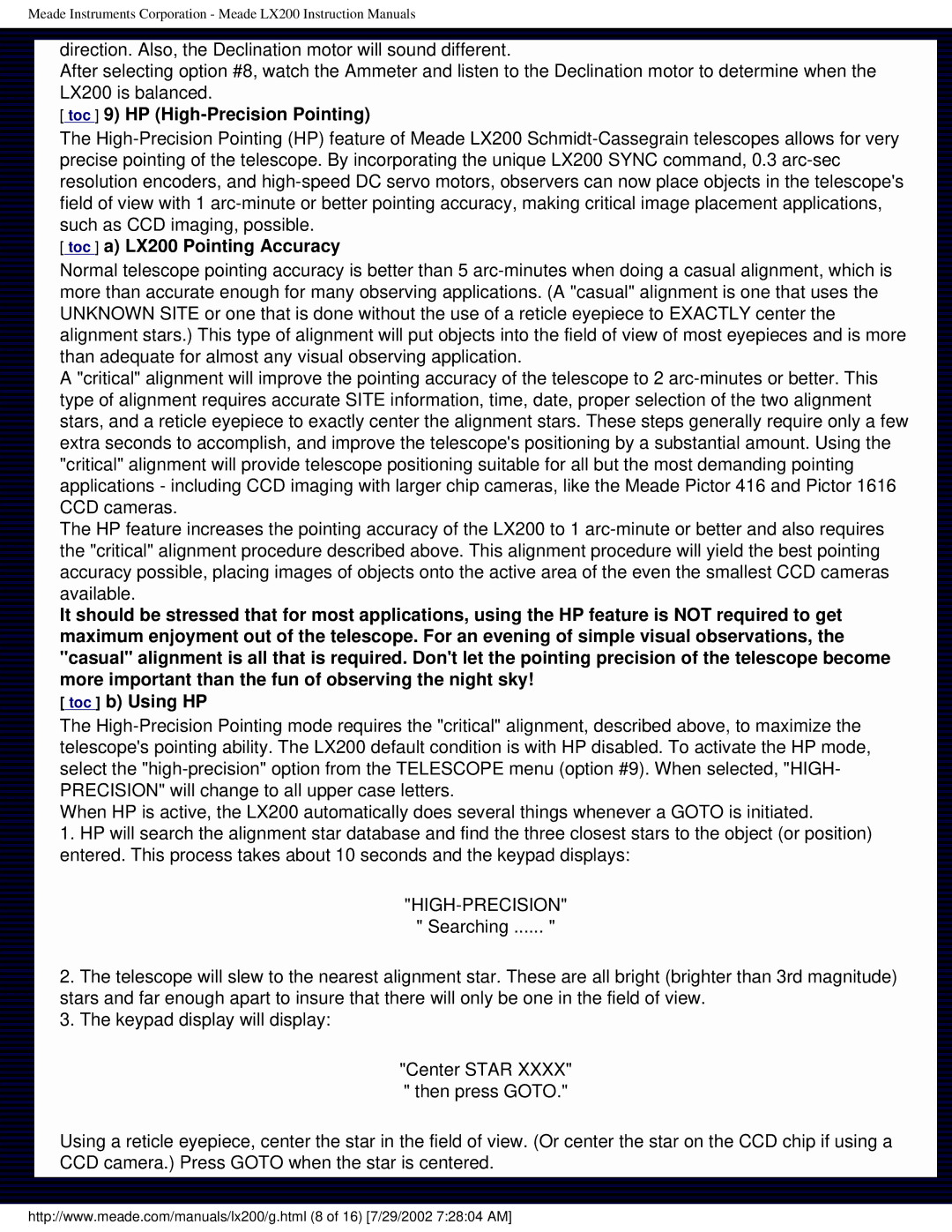Meade Instruments Corporation - Meade LX200 Instruction Manuals
direction. Also, the Declination motor will sound different.
After selecting option #8, watch the Ammeter and listen to the Declination motor to determine when the LX200 is balanced.
[ toc ] 9) HP (High-Precision Pointing)
The High-Precision Pointing (HP) feature of Meade LX200 Schmidt-Cassegrain telescopes allows for very precise pointing of the telescope. By incorporating the unique LX200 SYNC command, 0.3 arc-sec resolution encoders, and high-speed DC servo motors, observers can now place objects in the telescope's field of view with 1 arc-minute or better pointing accuracy, making critical image placement applications, such as CCD imaging, possible.
[ toc ] a) LX200 Pointing Accuracy
Normal telescope pointing accuracy is better than 5 arc-minutes when doing a casual alignment, which is more than accurate enough for many observing applications. (A "casual" alignment is one that uses the UNKNOWN SITE or one that is done without the use of a reticle eyepiece to EXACTLY center the alignment stars.) This type of alignment will put objects into the field of view of most eyepieces and is more than adequate for almost any visual observing application.
A "critical" alignment will improve the pointing accuracy of the telescope to 2 arc-minutes or better. This type of alignment requires accurate SITE information, time, date, proper selection of the two alignment stars, and a reticle eyepiece to exactly center the alignment stars. These steps generally require only a few extra seconds to accomplish, and improve the telescope's positioning by a substantial amount. Using the "critical" alignment will provide telescope positioning suitable for all but the most demanding pointing applications - including CCD imaging with larger chip cameras, like the Meade Pictor 416 and Pictor 1616 CCD cameras.
The HP feature increases the pointing accuracy of the LX200 to 1 arc-minute or better and also requires the "critical" alignment procedure described above. This alignment procedure will yield the best pointing accuracy possible, placing images of objects onto the active area of the even the smallest CCD cameras available.
It should be stressed that for most applications, using the HP feature is NOT required to get maximum enjoyment out of the telescope. For an evening of simple visual observations, the "casual" alignment is all that is required. Don't let the pointing precision of the telescope become more important than the fun of observing the night sky!
[ toc ] b) Using HP
The High-Precision Pointing mode requires the "critical" alignment, described above, to maximize the telescope's pointing ability. The LX200 default condition is with HP disabled. To activate the HP mode, select the "high-precision" option from the TELESCOPE menu (option #9). When selected, "HIGH- PRECISION" will change to all upper case letters.
When HP is active, the LX200 automatically does several things whenever a GOTO is initiated.
1.HP will search the alignment star database and find the three closest stars to the object (or position) entered. This process takes about 10 seconds and the keypad displays:
"HIGH-PRECISION"
" Searching ...... "
2.The telescope will slew to the nearest alignment star. These are all bright (brighter than 3rd magnitude) stars and far enough apart to insure that there will only be one in the field of view.
3.The keypad display will display:
"Center STAR XXXX" " then press GOTO."
Using a reticle eyepiece, center the star in the field of view. (Or center the star on the CCD chip if using a CCD camera.) Press GOTO when the star is centered.

